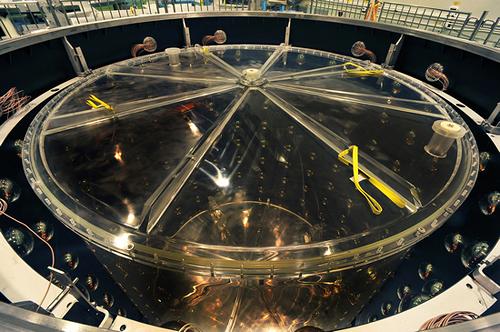 It was learned from the Institute of High Energy of the Chinese Academy of Sciences that the Daya Bay reactor neutrino experimental device located at the Guangdong Daya Bay Nuclear Power Plant was built over four years and two neutrino detectors were installed in the near-ground experimental hall measuring 100 meters underground and only 360 meters from the reactor. Neutrinos have been detected from nuclear reactor reactor groups. This indicates that the Daya Bay International Cooperation Group has taken the first step in the measurement of the third mode of oscillation of the neutrino, and the experimental results are likely to provide clues as to why there is more substance than antimatter in the universe.
It was learned from the Institute of High Energy of the Chinese Academy of Sciences that the Daya Bay reactor neutrino experimental device located at the Guangdong Daya Bay Nuclear Power Plant was built over four years and two neutrino detectors were installed in the near-ground experimental hall measuring 100 meters underground and only 360 meters from the reactor. Neutrinos have been detected from nuclear reactor reactor groups. This indicates that the Daya Bay International Cooperation Group has taken the first step in the measurement of the third mode of oscillation of the neutrino, and the experimental results are likely to provide clues as to why there is more substance than antimatter in the universe. Neutrinos are an elusive basic particle with very little mass and no charge. Solar, cosmic rays, nuclear power plants, etc. can produce a large number of neutrinos. It is extremely difficult to detect, hardly interacts with matter, and can easily pass through the human body, buildings and even the earth without any influence. There are three types of neutrinos: electron neutrinos, μ neutrinos, and τ neutrinos. They can change from one type to another by shaking.
The Daya Bay experiment is a measure of the third oscillation mode of neutrinos. In this oscillation mode, the mixed state consisting mainly of electron neutrinos transforms into a mixed state consisting mainly of tau neutrinos. This is the last unknown mixing angle, called θ13, whose magnitude determines the direction of future neutrino physics research and is related to the mystery of the disappearance of antimatter in the universe. Scientists at the Daya Bay Laboratory expect that it will take about two years to achieve the experimental goal of measuring θ13 to 1% accuracy.
According to Wang Yafang, executive spokesman of the Daya Bay Experimental Cooperation Group and executive deputy director of the High Energy Institute of the Chinese Academy of Sciences, eight scientific proposals for neutrino have been proposed internationally. The Daya Bay experimental program proposed by the Chinese scientists has unique geographical advantages and unique design, and has received extensive international support. The U.S. Department of Energy has abandoned its two experimental programs for supporting the country and has instead supported the cooperation of U.S. scientists in the Daya Bay experiment. The Daya Bay International Cooperation Team, which was established since 2006, has now been developed into 39 research institutions and 250 researchers from 6 countries and regions. The Chinese funding for the experiment was jointly supported by the Ministry of Science and Technology, the Chinese Academy of Sciences, the National Natural Science Foundation of China, Guangdong Province, Shenzhen City, and the China Guangdong Nuclear Power Group. It has created a precedent for the country, local governments, and enterprises to jointly support basic scientific research. China Guangdong Nuclear Power Group gave valuable support to the construction of the Daya Bay reactor neutrino experiment. This experiment is one of the largest cooperation between China and the United States in basic research, and is the second largest particle physics experiment project that the US Department of Energy invests abroad.
"The first data obtained from Daya Bay allowed us to start measuring this unknown mixing angle and eventually measure the oscillation amplitude within 1% accuracy." A spokesman for the Daya Bay Cooperative Group from the US Department of Energy's Lawrence Berkeley National Laboratory Says, "This accuracy is an order of magnitude higher than the current measurement, and it is much more accurate than other experiments in progress. The results of the experiment will explain the evolution of basic matter in neutrinos during the earliest period after the Big Bang. The role played in the process, and why the matter in the universe today makes more significant contributions than antimatter."
China and the United States led the Daya Bay reactor neutrino experiment and also included collaborators from Russia, the Czech Republic, Hong Kong, China, and Taiwan. Domestic units include 15 research institutes and colleges such as the Institute of High Energy Research of the Chinese Academy of Sciences, Tsinghua University, University of Science and Technology of China, Nanjing University, Shanghai Jiaotong University, and Shandong University.
Rail Plastic dowel(Rail Plastic Sleeve)
Rail plastic dowel is also called rail plastic sleeve/plastic insert/concrete dowel/ concrete insert, which is a counter-party fastener for a screw spike or anchor bolt, and it is pre-imbedded into the concrete sleeper or wooden sleeper, installed together with Screw Spikes, guide plates and rail clips to fasten the rail tracks.
Plastic Sleeve,Nylon Plastic Dowel,Customized Nylon Lock Dowel,Plastic Nylon Sleeve
Anyang Railway Equipment CO.,Ltd , https://www.ayrailwayat.com